Dreams Take Flight
R-jay's Journey through the SEA-Teacher Program"
✢ 2023 ✢
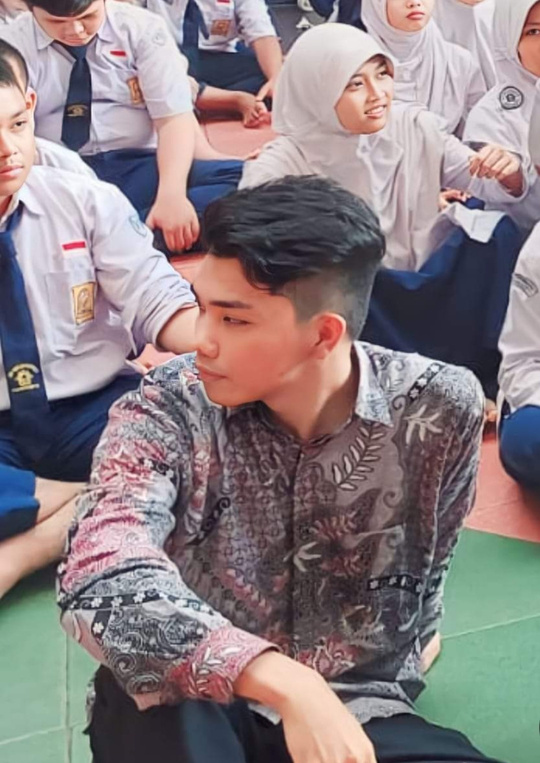
About me
R-jay O. Santos

Hey there, I'm R-jay Santos, a 4th-year BEEd student from President Ramon Magsaysay State University. Embarking on this exhilarating journey as a 23-year-old Elementary Major-Practice Teacher, currently in the throes of my fourth year at President Ramon Magsaysay State University-Iba Campus (PRMSU). My academic adventure took an international twist as I found myself at Universitas Muhammadiyah Purwokerto (UMP). The program spans from September 16th to October 11th, 2023, and I'm thrilled to be part of the 9th batch of the SEA-Teacher Program.
This experience is going to be a total game-changer for me. It's like investing in my future, and trust me, this is one investment I'll never regret.
Join me about the ups and downs, and all the magical moments of my SEA-Teacher adventure last month. Let's dive in, together, and uncover the wonders this program has in store!
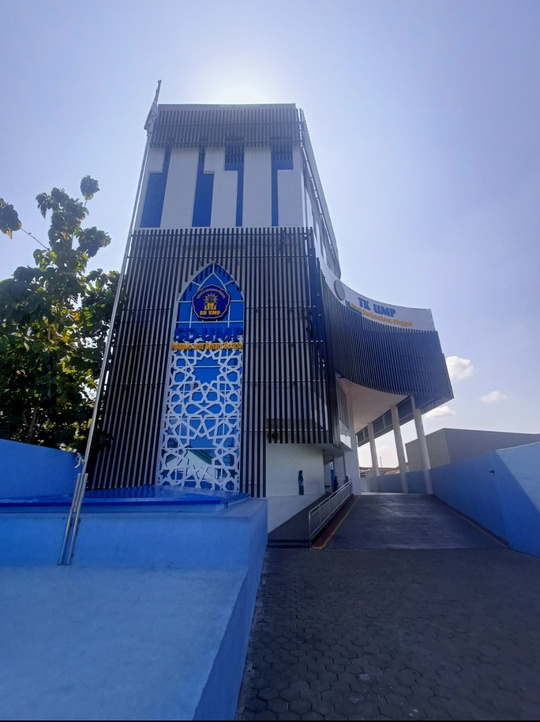
A.School Profile
SD UMP Elementary has chosen a prime location within the Banyumas Regency Government area, strategically positioned for easy access via existing transportation options. The school's surroundings are teeming with economic activities, health facilities, sports amenities, and places of worship, making it a vibrant hub for young learners.
You'll find UMP Elementary School situated at Jalan Raden Patah, RT 01, RW 04, Ledug Village, Kembaran District, Banyumas Regency. The campus spans across a generous 2,956 square meters of land, including , ground floor, 1st floor, 2nd floor, 3rd floor,4th floor, open spaces, and ample parking.
These diverse settings serve as pillars supporting the educational journey at SD UMP. The student body hails from middle to upper economic backgrounds, boasting the necessary resources to enrich both in-class and extracurricular learning.100% of the students are Muslim, unifying them in religious practice.
Sekolah Dasar
Universitas
Muhammadiyah
Purwokerto
A. Vision
The vision is set by the school community together with stakeholders.School programs and activities refer to the vision that has been set. School visionsocialized regularly. The following is the Vision of SD UMP: (1) realizationstudents who are faithful, pious, and have noble morals withimplement the values of Al Islam and Muhammadiyah ineveryday life; (2) SMART (Smart Education, Management School,Adaptive, Recognition, Technology).
B.Mission
The mission is structured so that the vision can be achieved. The mission is socialized to all
School residents described in programs and activities. UMP Elementary School's mission as
following:
1. Islami
a. Realizing education based on Al-Islam and Muhammadiyah.
b. Integrating the Al Islam Kemuhammadiyahan Curriculum with the Curriculum National.
c. Creating an Islamic learning environment.
d. Creating a school culture that has an Islamic character.
2. SMART
a. Smart Education
1) Increasing educational accessibility.
2) Improving the quality of education.
3) Develop digital skills in educational aspects.
4) Establishment of global collaboration on educational aspects.
b. Management School
1) Providing quality education.
2) Develop students' critical skills.
3) Encourage innovative and progressive attitudes.
4) Building school networks and partnerships
c. Islamic Learning Environment aims to create an environment Islamic learning in schools. This involves setting up and design of classrooms, libraries, and other facilities that reflect Islamic values. The application of Islamic ethics and manners will be promoted in interactions between students, teachers and school staff. Schools can too providing prayer space, holding religious activities, and facilitate spiritual experiences for students.
d. Creating a school culture with an Islamic character aims to
fostering strong Islamic character in students. School will focus
on the development of noble morals, honesty, responsibility, justice,
simplicity, and mutual respect. Development program
character will involve teaching, extracurricular activities, as well as roles
active from teachers and school staff in strengthening these values in
students' daily lives.
2. SMART
a. Smart Education
1) Increasing accessibility aims to provide access to education
which is easy for students both online and offline with use of technology.
2) Improving the quality of education aims to improve quality education through the application of intelligent and innovative technology.Learning approach tailored to participant needs educate by utilizing artificial intelligence, data analytics, and digital-based learning.
3.) Improving the quality of education aims to improve quality education through the application of intelligent and innovative technology.Learning approach tailored to participant needs educate by utilizing artificial intelligence, data analytics, and digital-based learning.
4) Development of digital skills aims to help participants students and educators develop the necessary digital skills in the era of information and communication technology. Training and resources will be provided to improve digital literacy, skills programming, and problem solving.
5) Global collaboration aims to facilitate collaboration and exchange of knowledge between educational institutions internationally.Technology will be used to connect students, educators,and researchers from various countries.
b. Management School
1) Providing quality education aims to provide
high quality education through good school management will provides a comprehensive and relevant curriculum that includes various aspects of management, including financial management, marketing,human Resources.
2) Developing critical thinking skills aims to develop critical skills needed by students. Critical skills will focus on developing analytical skills, leadership, communication, problem solving, and retrieval effective decisions.
3) Encouraging an innovative and progressive attitude aims to encourage
progressive innovation. Educators and students are encouraged to
think creatively, develop new ideas, and design solutions innovative.
4) Building networks and partnerships aimed at helping participants
students build strong networks and connections in the world of education. Through partnerships students will be given access to knowledge and practical experience of students.
c. Adaptive
1) Building an adaptive culture aims to build an adaptive culture schools by encouraging flexibility, openness to change, and the ability to adapt quickly to new situations.
2) Anticipate changes and dynamics of education aimed at anticipating changes that occur in the dynamics of national education adaptively and flexibly.
3) Adopting the latest technology and processes aims to adopt the latest technology and processes in school management through activities monitoring and evaluating technological developments relevant to increasing efficiency, productivity and competitive advantage.
4) Building an evaluative and reflective culture aimed at learning from experience and be reflective through the process of analyzing the resultsevaluation to achieve improvement. Feedback/reflection will be used to make continuous improvements.
d. Recognition
1) Strengthen motivation and build a culture of target achievement aims to achieve school success and achievement through high motivation, educators, educational staff, and students Motivated to work hard and strive to achieve school goals.
2) Building a culture of appreciation aims to increase motivation student learning and work motivation of educators and education personnel resulting in increased performance.
3) Building a culture of service excellence (maximum service) aims to provide a customer experience that outside Customers/parents/guardians must feel valued, heard and satisfied with the services provided. This includes being responsive to customer requests, providing solutions that meet needs them, and provide service with a friendly, empathetic and professional. normal
e. Technology
1) Utilization of technology based on deeply integrated information systems Learning aims to help improve quality learning through the provision of digital resources, interactive tools, and multimedia content. Students can access learning materials in a more engaging, interactive and relevant way. Technology too can support project-based learning, collaboration between participants education, and a more comprehensive assessment.
2) Encourage the creation of sustainable innovation based on STEAM (Science, Technology, Engineering, Arts, and Mathematics) aims to develop creative thinking, problem solving abilities, and collaboration in overcoming social, economic and environmental challenges complex.
3) Presenting STEAM product-based learning aims to encourage students to develop practical skills, creativity, and innovation in designing, making, and presenting a physical product related to the concept STEAM (Science, Technology, Engineering, Arts, and Mathematics).
1.2 Academic Support System
SD UMP boasts an impressive array of facilities, ensuring a comfortable and conducive learning environment. Each classroom is equipped with air conditioners to keep students cool and focused. Moreover, all rooms are equipped with LCD TVs, adding a multimedia dimension to the learning experience.
For health and well-being, each floor features a clinic with beds, ensuring that any medical needs are swiftly attended to.
The school library is a treasure trove of knowledge, offering a rich collection of reference books, making research and learning a breeze.
And it's not just the students who benefit from modern amenities; teachers have access to essential tools such as computers, printers, and internet networks, enhancing their efficiency and effectiveness in delivering their educational responsibilities. It's all about creating an environment that supports both students and educators in their pursuit of knowledge.
Step into SD UMP and be wowed by their all-encompassing setup catering to every aspect of student life. From the lecture halls to the library, the spiritual sanctuary of the prayer room to specialized areas like the language and computer labs, every student need is met.
Smooth operations are a given with administrative spaces like the staff room and principal's office, along with designated spots for the teachers. SD UMP's commitment to student well-being shines with the availability of counseling and medical services.
But that's not all, there's plenty of fun to be had with a meeting room for collaboration a canteen for meals, and a covered court or gym where students can engage in sports activities. With such a diverse range of spaces, SD UMP Elementary School's approach to education is truly all-encompassing.
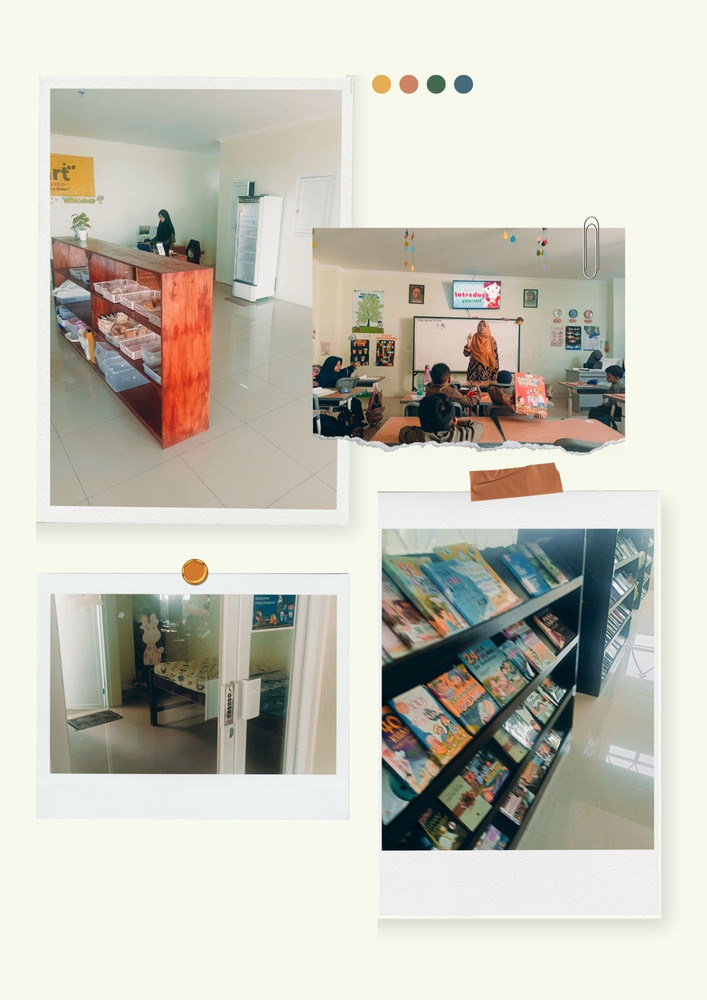
1.3 Teaching System
Teachers at UMP Elementary School employ a blend of educational resources, including books, PowerPoint presentations, and handouts. These materials are designed to enable students to engage with the subject matter before arriving at school, allowing for a more interactive and focused classroom experience.
The school week spans five days, with classes commencing at 06:30 a.m. and concluding at 01:30 p.m., though the schedule may extend into the afternoon to accommodate extracurricular activities. This flexible approach to teaching ensures that students have access to a variety of learning models tailored to the specific topic under study.
.
B.PEDAGOGICAL Contents
1.1 TEACHING methods of the teacher that you observed
At SD UMP, the teaching methods are like a rich tapestry, woven to support student learning. Teachers employ a mix of techniques, from traditional lectures and engaging discussions to collaborative group work. Problem-based learning and project-based learning are also key components, adding depth and hands-on experience to the education.
What's truly special is the emphasis on personalization. Teachers are encouraged to not only use a diverse array of teaching methods but also to adapt their approach to suit the unique needs and interests of each student. It's all about creating an environment where learning is as individual as it is comprehensive.

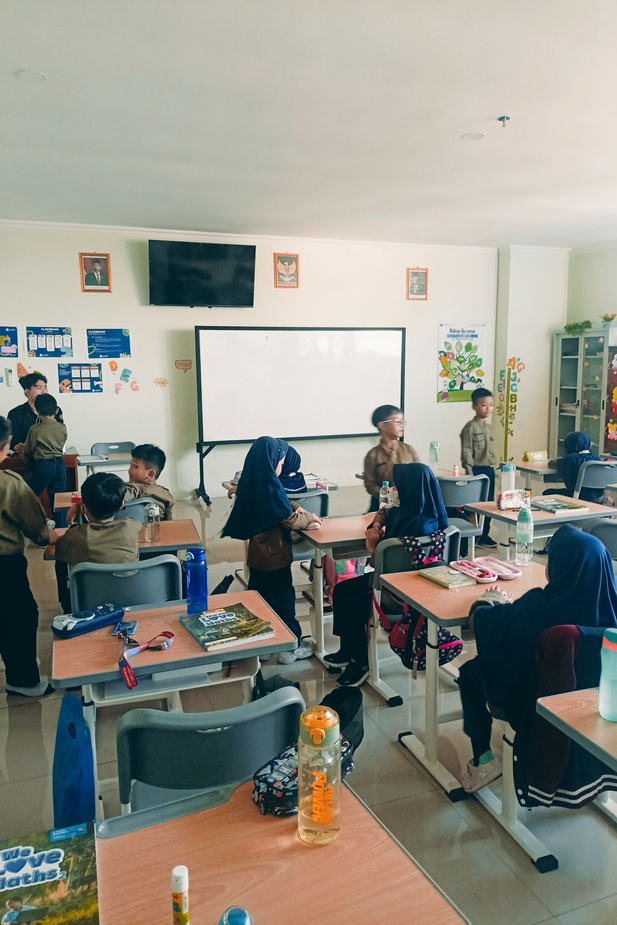
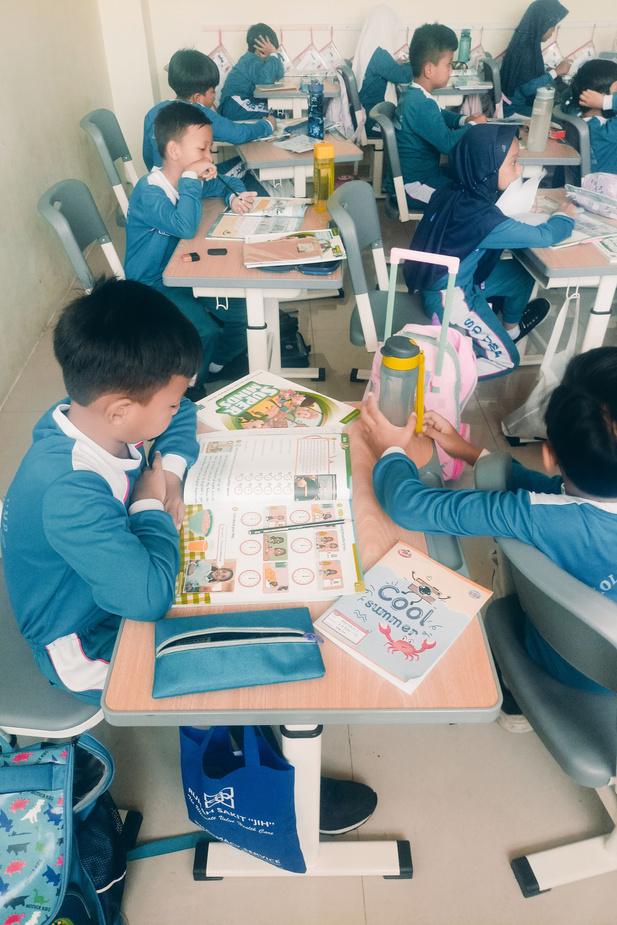
1.2 Their learning materials and innovation
At UMP Elementary School, the learning materials are as diverse as the subjects themselves. Teachers use a range of tools, including PowerPoint presentations, captivating YouTube videos, and the trusty whiteboard to keep lessons engaging.
But what sets the teaching approach apart is the personal touch. Teachers often craft questions that are presented directly to the students, making the learning experience interactive and thought-provoking.
Moreover, the choice of learning materials isn't one-size-fits-all; it's tailored to the specific topic at hand. Sometimes, teachers take a more visual approach, using the whiteboard for illustrations or bringing in classroom objects to spark students' curiosity and connect the learning to their everyday surroundings. It's all about making learning come alive!
During my observation of my mentor, I noticed a thoughtful use of technology in education. Specifically, she employed the WhatsApp application to bridge the gap when a student was absent. This involved sending activities and materials to ensure that the absent student could catch up with the day's lessons seamlessly. It's a clever integration of technology for the benefit of student learning and engagement.
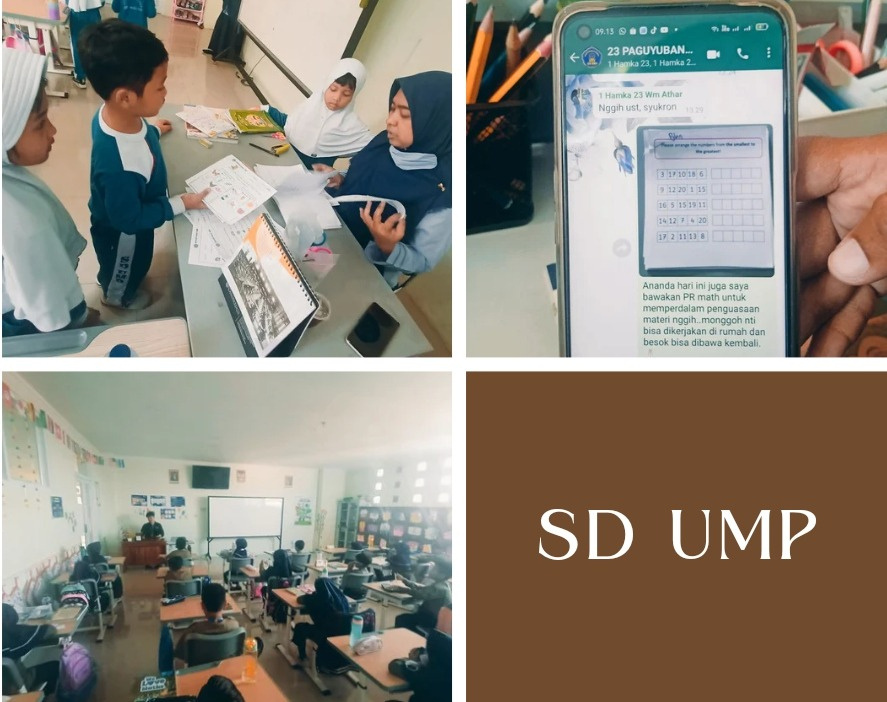
1.3 Sources of learning and technology used by the teachers
In the classroom, I observed the teacher employing a diverse range of materials and methods to ensure an engaging and effective learning experience. These included student books, workbooks, visual aids like pictures, a trusty whiteboard, and multimedia in the form of YouTube videos.
The teacher utilized various resources, incorporating the subject syllabus, online materials, textbooks, and dynamic PowerPoint presentations to drive the learning process.
Interaction was a key feature of the class. The teacher regularly posed questions, and the students responded promptly. Subsequently, the teacher would delve into the rationale behind the answers, fostering a deeper understanding. To wrap up the learning session, the teacher provided reinforcement, ensuring that the key takeaways were firmly embedded before concluding the class. It's all about creating an engaging and fruitful learning atmosphere
The use of Cambridge textbooks reflects a global standard, ensuring students have access to a comprehensive and internationally recognized educational resource.
The teachers SD UMP have embraced technology to enrich their teaching methods. Instead of lugging around a stack of textbooks, they utilize the internet to access teaching aids, ensuring that the students have access to the necessary activities that they need to complete.
Moreover, technology plays a prominent role in the classroom, with each room equipped with a smart TV. This integration of technology is aimed at transforming the learning experience, making it more engaging, interactive, and pertinent to the students. The ultimate goal is to foster an environment where sustainable innovation can flourish, bringing education to life in exciting new ways!
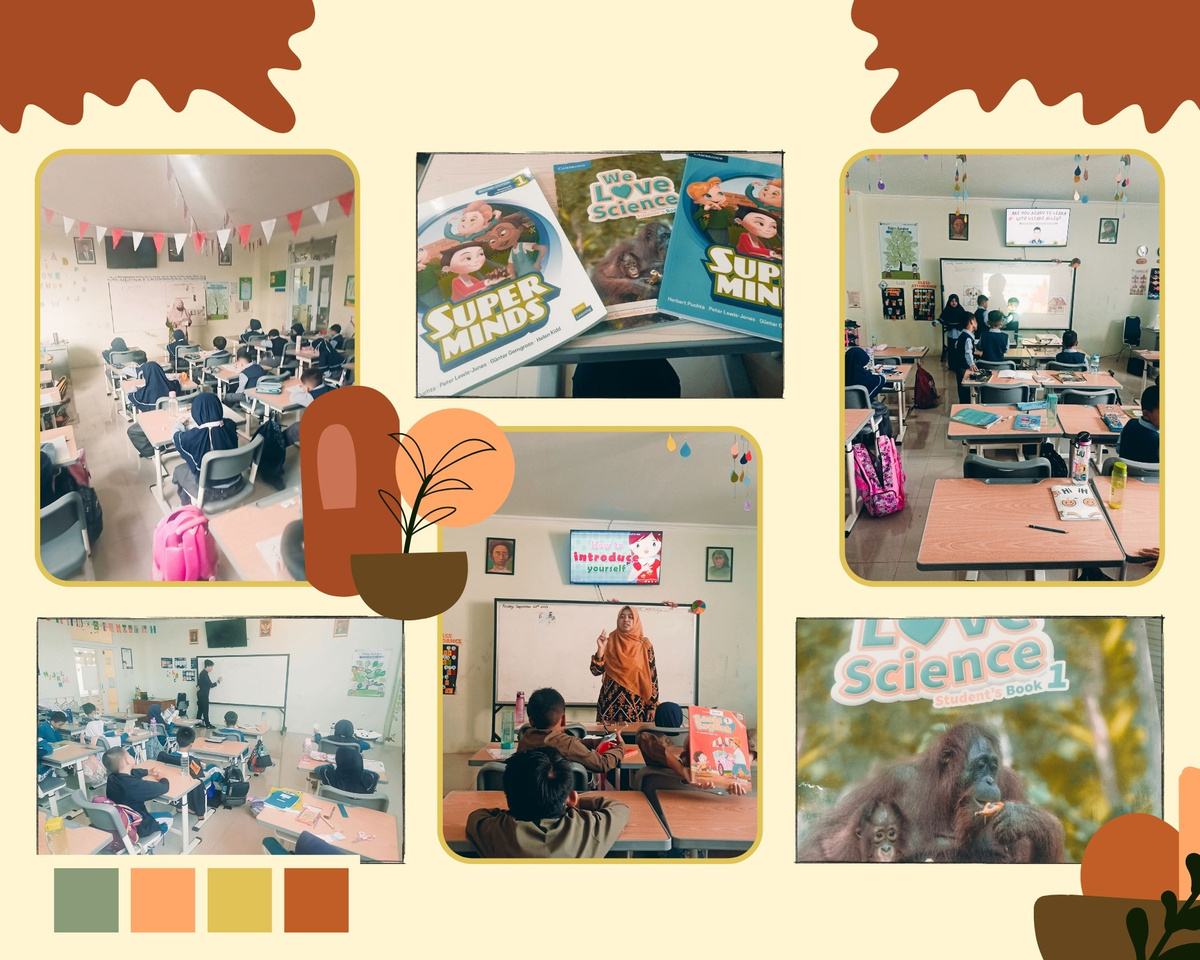
1.4 TEACHING methods of the teacher that you observed Authentic assessment used by the teachers
Educators at UMP Elementary School take a comprehensive approach to assessment, focusing on attitudes, knowledge, and skills. This means that they assess a wide range of aspects to gain a holistic view of students' le.arning outcomes. Assessment techniques include written tests, oral tests, practical demonstrations, projects, portfolios, and other methods that align with the specific competencies being evaluated.
What's interesting is how the results of these assessments aren't left idle. They are carefully analyzed and evaluated to gauge the effectiveness of the learning process. Additionally, there's a hands-on element to this process. Students actually visit their teacher's desk for a one-on-one review of their work. This personal touch in assessment ensures a thorough understanding of each student's progress and needs. It's all about fostering a rich and engaging learning environment!

1.1 Curriculum
The curriculum at UMP Elementary School is thoughtfully divided into three phases: Phase A for class I and II, Phase B for class III and IV, and Phase C for class V and VI. This curriculum combines both thematic and subject-based learning, featuring clear and measurable learning objectives that offer valuable feedback on student achievement.
What's truly engaging is the use of teaching materials, dynamic learning activities, assessments, and a variety of resources that are not only educational but also captivating, contextually relevant, and enjoyable.
The curriculum spans across a wide range of subjects, from Natural and Social Sciences to Arts and Culture, Physical Education, Sports, and Health. Additionally, Islamic Education is integrated, covering Creed, Ethics, Al-Qur'an, and Culture.
This curriculum distinguishes itself with its simplicity, contemporary relevance, and clarity, ensuring that learning objectives are easily understood and attainable. It's an education designed to be accessible and enriching for all students.
C.Teaching Plan
SD UMP truly believes in nurturing students' diverse talents and interests. They offer a staggering 28 different extracurricular activities, spanning the realms of sports, arts, culture, and even academic and scientific competitions.
These activities serve as powerful tools for honing skills and discovering new passions. They not only offer students an avenue to explore their interests but also provide opportunities for improving their ability to articulate ideas, solve problems, create products, and enhance their literacy and numeracy skills.
What's remarkable is that SD UMP fosters a rich variety of learning models, allowing these extracurricular activities to take various forms, from self-development initiatives to counseling services and project-based learning. It's all about providing a well-rounded education and allowing students to flourish in their own unique ways.
1.2 Teaching plan related to your major
The Lesson Plan at SD UMP is quite comprehensive, covering various essential components. It starts with details about the teacher, school's name (SD UMP), lesson, grade/semester, and time allocation.
Then, it delves into the educational meat and potatoes, listing the standard competencies, basic competencies, and lesson objectives. Following that, it highlights National Character Traits and Values.
The teaching method, planned learning activities, and focus of learning come next, providing a clear path for educators to follow. The teaching-learning procedures, media and resources, and assessment round out this extensive plan
Lesson plan of Ma'am Nofra Ilwana, S.Pd., Gr.
My Lesson Plan
D. Teaching Practice
1.1 Procedures of teaching
I had the pleasure of teaching Grade 1 in the Jenseod class, focusing on the fascinating world of living things and non-living things. To kick things off, I greeted them with a warm "Selamat pagi. Apa kabar hari ini?" (Good morning class. How's everyone today?). Then, I introduced myself as their teacher for the day.Knowing that English might be a bit tricky for them, I had a translated version of the lesson content ready in my PowerPoint.
For a little class motivation, I presented a picture of typical playground items and challenged them to spot the four odd items. At first, they were a bit shy, as we hadn't interacted much yet, but I encouraged them to participate, and they did.
After that, I explained the concepts, using both English and Bahasa Indonesia in my PowerPoint, ensuring they could grasp the ideas. I used examples and asked questions to keep the class engaging.
I had initially planned a group activity but had to skip it due to time constraints caused by a delayed start due to interruptions.
We wrapped up with a generalization or summary of our entire discussion. Lastly, I moved on to their individual evaluations, promising prizes for high scores. And, as homework, I handed out assignments. It was a busy, interactive day in class!
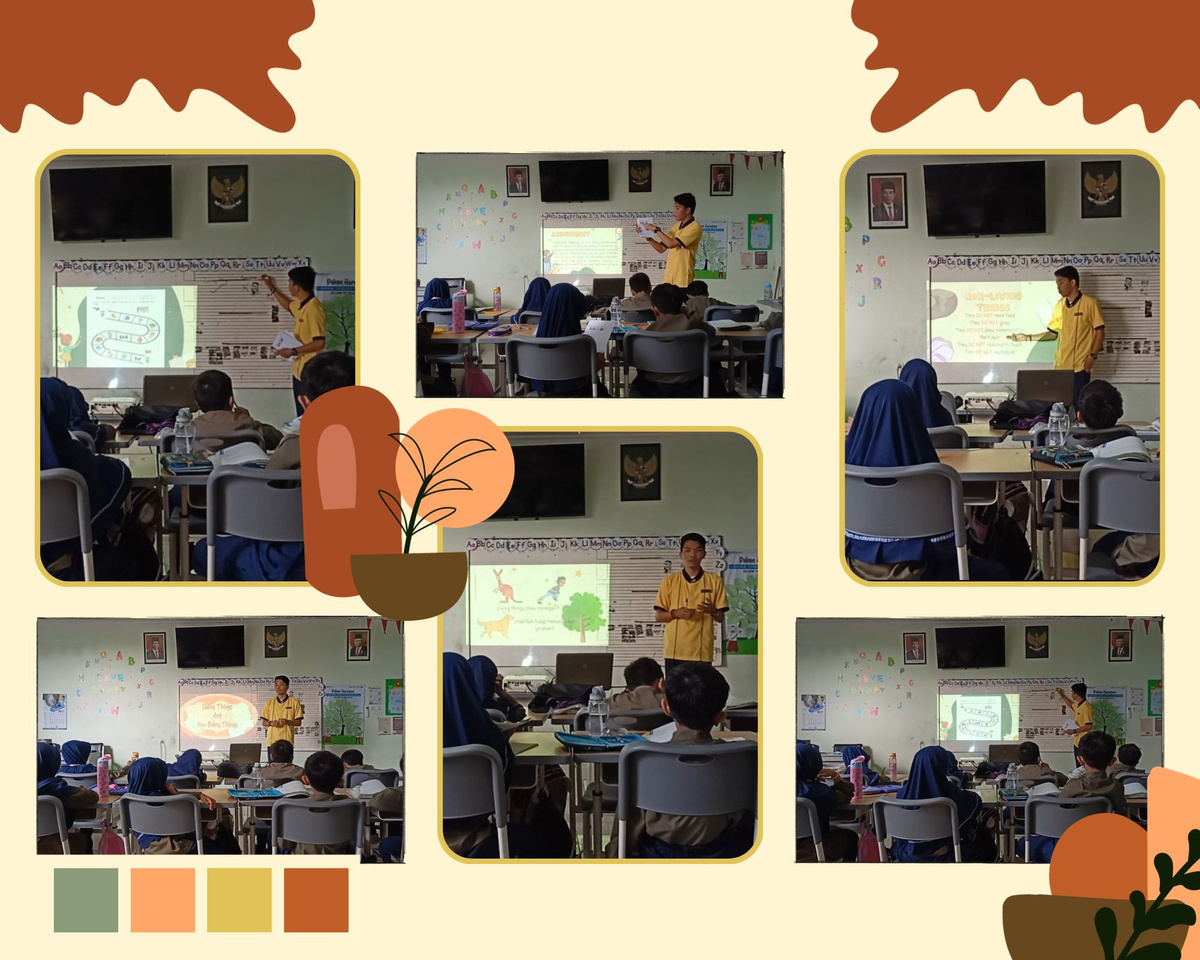
1.2 Time Management and Organizing Activities
I had this one science class in the morning on a Friday, and it was the very first subject on their schedule. The class was a 70-minute adventure, and I was all set to teach them about living things and non-living things. To make sure everything went smoothly, I got to school early, just in case there were any hiccups that needed fixing.
But, when I walked into the classroom, you won't believe it – there was no available projector, and I couldn't connect my laptop to the smart TV. Time was ticking away while I waited. At some point, I couldn't wait any longer, so I politely insisted on starting without the projector. I had to make the most of our limited time, after all.
And just when I had gotten into the teaching groove, the projector magically became available. I was asked to restart from the beginning, and well, I did. Teaching can be full of surprises, that's for sure!
I've got to give myself a pat on the back for this one – handling those class activities was right up my alley, and it became a real highlight of my teaching practice. The icing on the cake? Seeing those beaming students who, because of their stellar performance, each went home with a shiny prize. It was a heartwarming win-win for everyone involved!
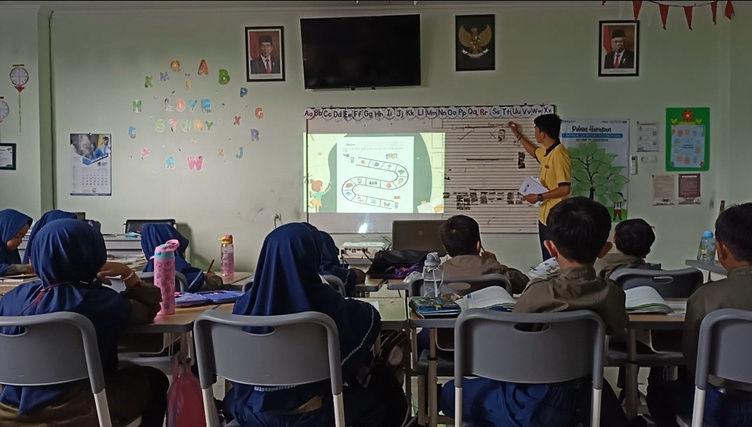
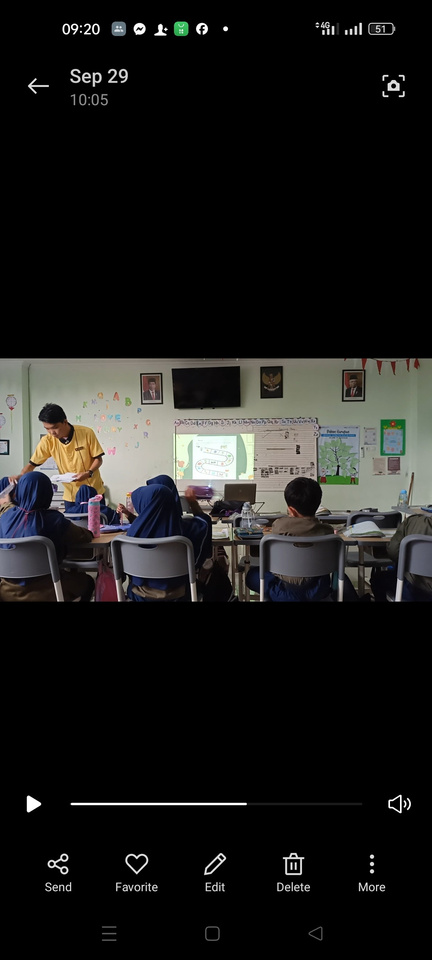
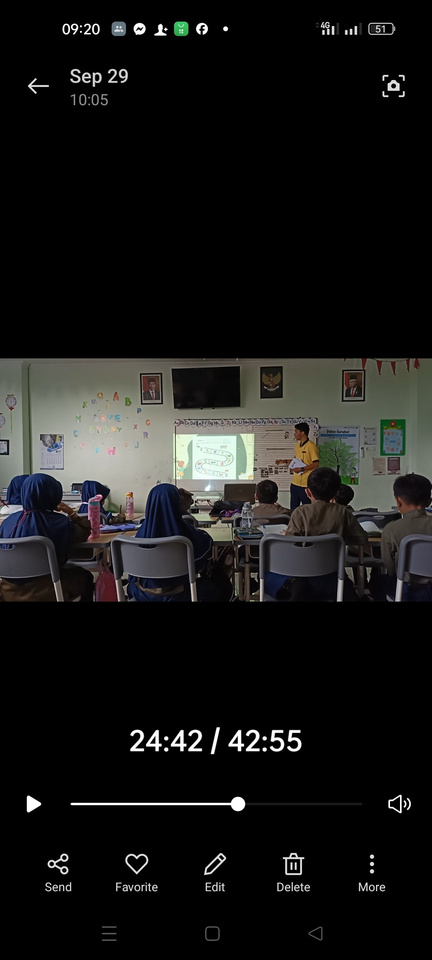
1.3 Classroom Management
Before I kickstart my teaching sessions, I always take a moment to gently remind my students of some fundamental classroom etiquette. It's the basics, really – things like listening when someone's speaking, being kind even if a classmate falters, actively participating, and ensuring they're seated properly.
Now, let me share the unique twist in our teaching adventure. Our teaching practice was originally slated for the third week, but due to exams and a jam-packed schedule, it got bumped to the second week. As you'd expect, this altered dynamic added a little shyness in the beginning, since we didn't have as much classroom interaction time as we'd like.
Nonetheless, I must say, the students have been quite well-behaved. However, there's one quirk I've noticed – when it's time to answer questions, they don't really raise their hands. It seems like they're not entirely accustomed to these customs, and occasionally, the rules slip their minds. It's all part of the learning journey, and together, we're working on refining these classroom norms!
1.4 Problem Solving
In terms of problem-solving, I'm delighted to share that the students excelled. I provided instructions in English along with translations in Bahasa Indonesia, which made it a breeze for them to tackle the problems. Their initial shyness didn't hinder their problem-solving skills during our discussion. It was a fantastic display of their abilities!
1.1 Purposes of practicum (meets or not meets your need)
The Sea Teacher Project is on a mission to fling open doors for bright-eyed educators from universities across Southeast Asia. This isn't just about getting practical teaching experience; it's a total transformation of skills and knowledge in international settings.
The Sea Teacher Program is like no other, it's a chance for budding teachers to upgrade their skills, pump up their teaching chops, and bring a world of new perspectives into their classrooms. The end game? To give these educators the power to compare teaching methods and enrich their pedagogical toolkit.
As for me, every classroom interaction, every cultural exchange, and every challenging moment I faced adapting to diverse educational settings added vibrant hues to the canvas of my professional growth. This wasn't just about teaching; it was an immersive encounter with education on a global scale, an expedition that broadened my horizons and left an indelible mark on my understanding of the rich tapestry of global education.
For suggestion, financial support from the sending universities can be a motivating factor for students, especially considering the various expenses involved in participating in a practicum.
Summary and Suggestions
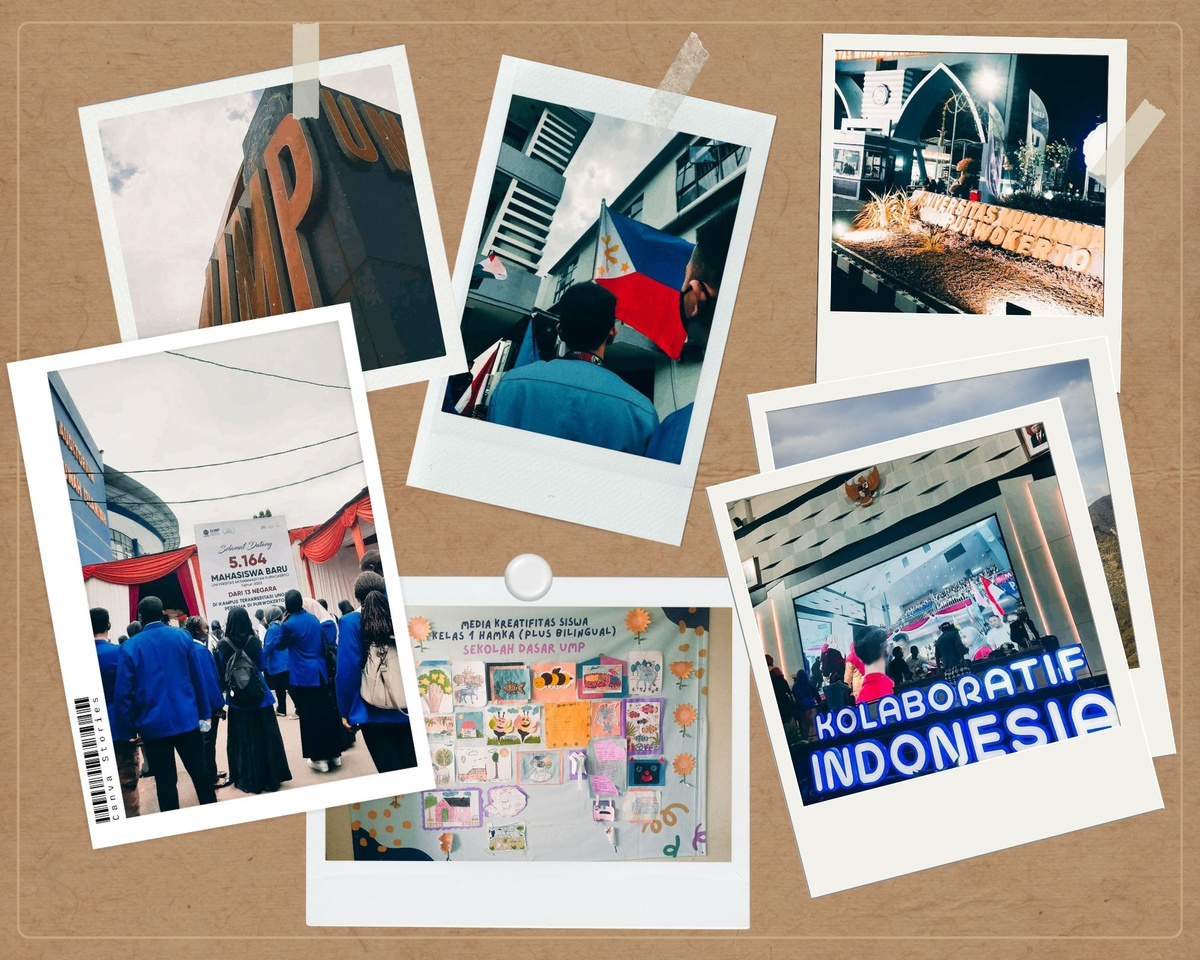
1.2Procedures of practicum
Embarking on this incredible 28-day internship journey, our voyage began at Yogyakarta International Airport on September 16, 2023. The first week was all about observation – soaking in the school's system, keenly watching how teachers conducted their classrooms. I had the privilege of observing the 1st-grade Hamka and Jenseod classes, delving into the intricacies of lesson planning, and closely inspecting their classroom management and board displays.
The second week marked the start of my teaching adventure, originally scheduled for the third week. However, due to an upcoming exam, I found myself leading lessons in the Jenseod class earlier than expected. It was a fantastic opportunity to teach both English and Science to the same eager class.
As we delved into the final week, my role shifted to assisting my cooperating teacher in class management and meticulously reviewing the students' answers. It was a dynamic and fulfilling journey, brimming with learning and growth.
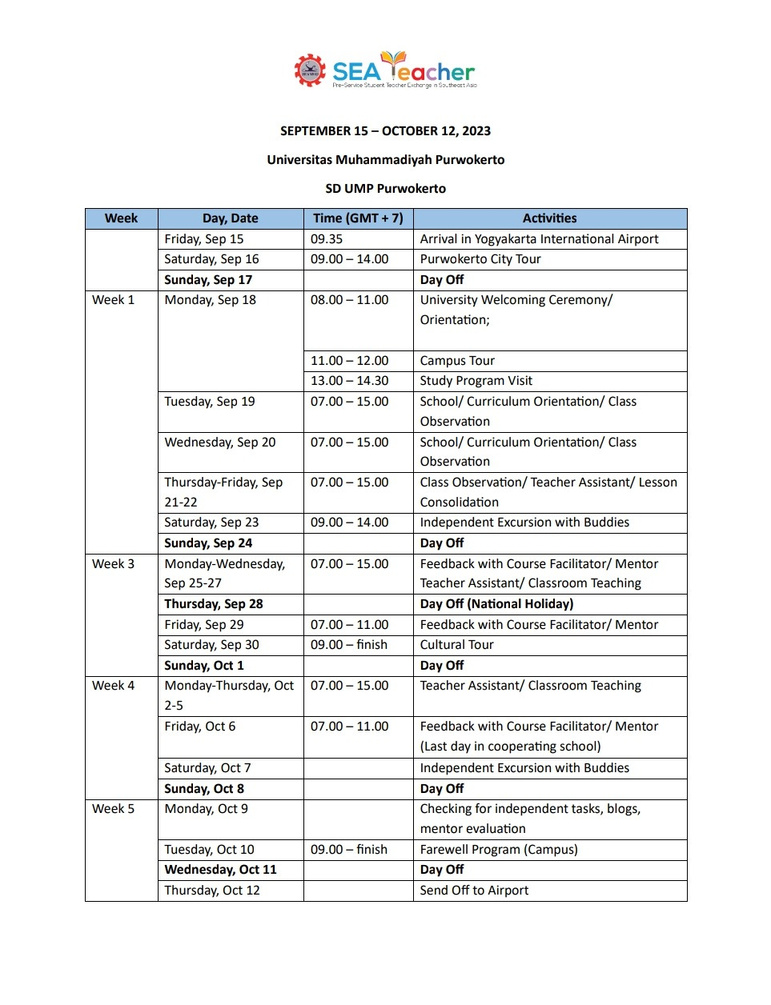
1.3 Outcomes of Practicum
This program has been a treasure trove of learning experiences. The journey has been filled with valuable insights, from honing my communication skills to understanding the nuances of different teaching methods in the classroom. It's been a deep dive into the educational system of our host country, a rich learning adventure.
But that's not all; this experience has been a window into diverse cultures, each unique and distinct from my own. It's been eye-opening and enlightening, broadening my horizons beyond borders.
And then there's the beautiful tapestry of friendships woven along the way. I've had the privilege of making friends from different corners of the world, each bringing their own stories and perspectives. This journey has not only been about discovering others but also about getting to know myself on a whole new level. It's a chapter of my life that I'll forever cherish.

1.4 The challenges of practicum
One of the most significant challenges that I encountered during this internship was the language barrier. Communicating in Bahasa Indonesia proved to be quite a hurdle as English wasn't commonly used in daily life. Teaching and interacting with students became a bit of a puzzle at times. To bridge this gap, I resorted to adding translated text to my teaching materials, ensuring that my students could grasp the content effectively.
Being mindful of the local preference for spicy foods, I approached each culinary exchange with care. As I'm not particularly adept at handling spicy dishes.This cultural adaptation became a flavorful part of my daily interactions, ensuring my dining experiences were both enjoyable and within my comfort zone.
Another hurdle that I faced was the occasional battle with fever. Perhaps it was due to the strain of travel and sleep deprivation, but it did interrupt my interactions with others. However, I'm proud to say that I didn't let it deter me, and I soldiered on without taking any absences. It was all part of the adventure
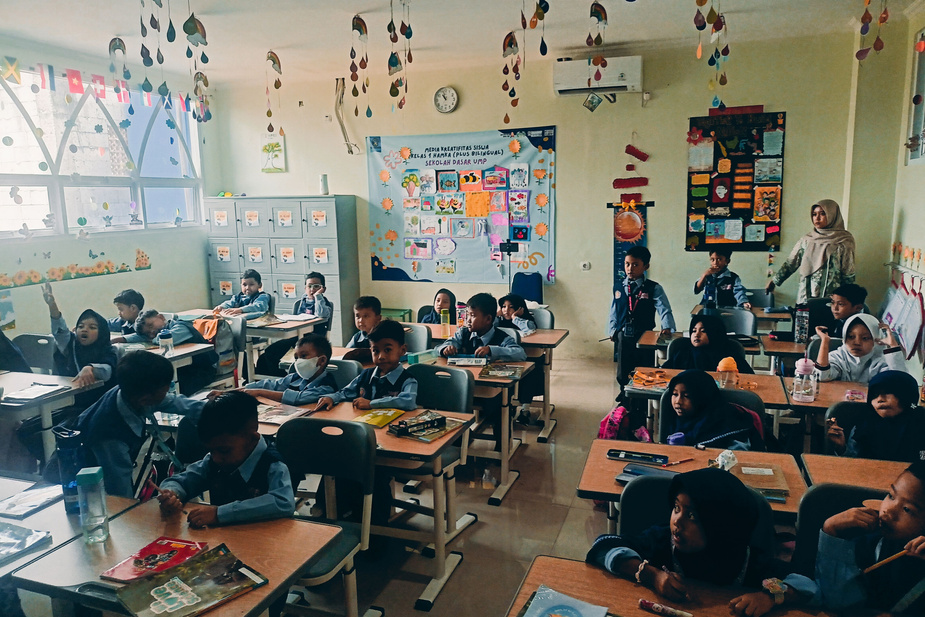


Summing up my whirlwind 28-day internship, the overall impression is one of profound growth and self-discovery. This journey, though not without its hurdles, has been a priceless learning experience. I had the privilege of delving into a different educational system and culture, and it expanded my horizons in countless ways. The language barrier was a considerable challenge, but it taught me the value of effective communication and resourcefulness. I adapted my teaching materials to bridge the linguistic gap, ensuring my students could grasp the content.
The connections I formed with my students and the friendships I forged with fellow interns from around the world are precious gems I'll forever hold dear. The adventure of teaching, even amid the occasional fever, made me more resilient and determined. Ultimately, this internship wasn't just about teaching; it was a journey of embracing differences, fostering understanding, and gaining a deeper insight into my own capabilities. It's a chapter in my life filled with both obstacles and triumphs, and I wouldn't exchange it for anything. This experience will continue to shape my perspective and enrich my experiences for years to come.
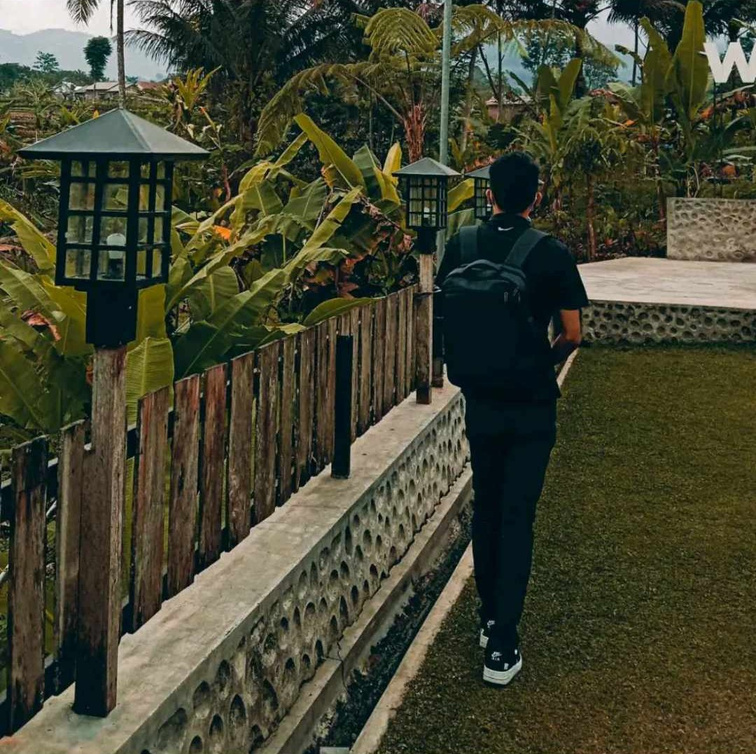
Email Address
rjaysantos723@gmail.com
Phone Number
09455814363
Let the Sea Teacher Exchange Student Teacher Program be your vessel of knowledge, your passport to cultural understanding, and your gateway to a future where education knows no borders. The world awaits your unique contribution to the symphony of global learning.
Terimah Kasih!